

Australian nanovaccine to protect against country's worst cattle virus. A world-first cattle vaccine based on nanotechnology could provide protection from the Bovine Viral Diarrhoea Virus (BVDV), which costs the Australian cattle industry tens of millions of dollars in lost revenue each year.
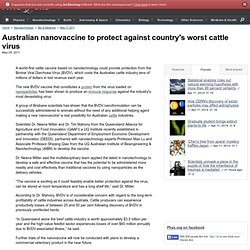
The new BVDV vaccine that constitutes a protein from the virus loaded on nanoparticles, has been shown to produce an immune response against the industry's most devastating virus. A group of Brisbane scientists has shown that the BVDV nanoformulation can be successfully administered to animals without the need of any additional helping agent making a new ‘nanovaccine' a real possibility for Australian cattle industries. Scientists Dr. Biochar stimulates more plant growth but lowers plant defence against pests and pathogens. Research at the University of Southampton has cast significant doubt over the use of biochar to alleviate climate change.
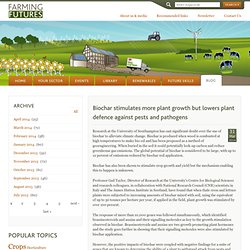
Biochar is produced when wood is combusted at high temperatures to make bio-oil and has been proposed as a method of geoengineering. When buried in the soil it could potentially lock-up carbon and reduce greenhouse gas emissions. The global potential of biochar is considered to be large, with up to 12 percent of emissions reduced by biochar soil application. Neonicotinoids barely found in pollen of seed-treated plants. Instead of spraying pesticides on plants growing in the field, seeds are treated with neonics before planting.

As the crops grow, the pesticide is taken up by the plants, protecting them from insect damage. A pest management toolbox to reduce pesticide use. Integrated pest management gains momentum due to European regulations on pesticides reduction.
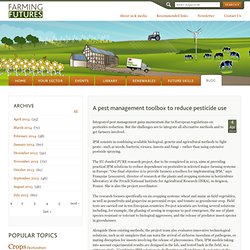
But the challenges are to integrate all alternative methods and to get farmers involved. IPM consists in combining available biological, genetic and agricultural methods to fight pests—such as weeds, bacteria, viruses, insects and fungi – rather than using extensive pesticide spraying. The EU-funded PURE research project, due to be completed in 2015, aims at providing practical IPM solutions to reduce dependence on pesticides in selected major farming systems in Europe.
Disease risk predicted by climate tool. Mon, 14 Apr 2014 EU - A tool to calculate the risk of food and waterborne diseases under current or future climate change conditions has been established following a recent EU funded study.
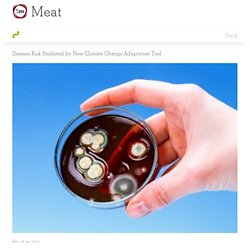
Free to use, the online tool can help guide climate change adaptation, such as improvements to water management, by estimating the likelihood of contracting four diseases under a range of environmental conditions. It is known that climate affects health, for example, excess rainfall can cause sewage overflow, leading to outbreaks of waterborne disease, and higher temperatures can influence disease incidence by either encouraging or restricting pathogen reproduction, depending on the species. Concerns have therefore been raised about the impacts of climate change on public health.
This study was funded by the European Centre of Disease Prevention and Control (ECDC), an agency of the EU. This allows estimates of infection risk under current and future climates to be compared. Fire ant control. By Sandra Avant April 11, 2014 U.S.
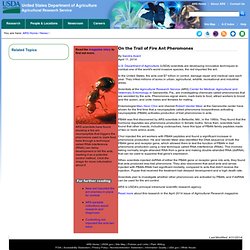
Department of Agriculture (USDA) scientists are developing innovative techniques to combat one of the world's worst invasive species, the red imported fire ant. In the United States, fire ants cost $7 billion in control, damage repair and medical care each year. They infest millions of acres in urban, agricultural, wildlife, recreational and industrial areas. Plants Host Pathogenic Bacteria from Livestock Farming - The Cattle Site. News Plants Host Pathogenic Bacteria from Livestock Farming 14 April 2014 NETHERLANDS - Disease-causing bacteria resulting from livestock farming can contaminate food products and find their way to humans.
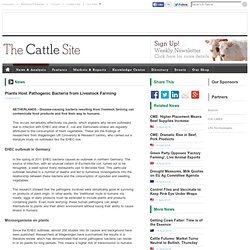
Plant Quarantine between Thailand and China. Free Trade Area (FTA) reached and validated between ASEAN and China has promoted plant and plant products trade dramatically between Thailand and China since 2000.
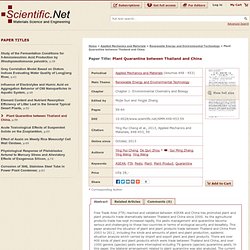
As the agricultural products trade has kept increased rapidly, the pests management and quarantine become serious and challenging to these two countries in terms of ecological security and biosafety. This paper analyzed the situation of plant and plant products trade between Thailand and China from 2003 to 2012, including the kinds and amounts of plant and plant production, epidemic situation analysis which carried by import and export plant and plant products. RTLS: The technology tracking cows to make them happy. When Asger Christensen started farming there were 40,000 dairy farmers in Denmark.
An Error Occurred Setting Your User Cookie. This site uses cookies to improve performance.
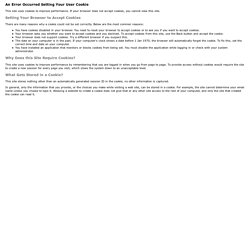
If your browser does not accept cookies, you cannot view this site. Setting Your Browser to Accept Cookies There are many reasons why a cookie could not be set correctly. Below are the most common reasons: You have cookies disabled in your browser. Why Does this Site Require Cookies? New foot-and-mouth vaccine. Scientists have developed a new methodology to produce a vaccine for foot-and-mouth disease virus (FMDV). Because the vaccine is all synthetic, made up of tiny protein shells designed to trigger optimum immune response, it doesn't rely on growing live infectious virus and is therefore much safer to produce and there is no chance that it could revert to an infectious form.
This collaborative research was led by Professor David Stuart, Life Science Director at Diamond Light Source and MRC Professor of Structural Biology at the Department of Medicine University of Oxford and Dr Bryan Charleston, Head of Livestock Viral Diseases Programme at The Pirbright Institute. Professor David Stuart, explains, "What we have achieved here is close to the holy grail of foot-and-mouth vaccines. Unlike the traditional vaccines, there is no chance that the empty shell vaccine could revert to an infectious form. Clinical trials have shown it is as effective as current vaccines.
High immunity cows soon available. Sires with a higher natural level of disease resistance will soon be available for farmers to buy, thanks to the latest technology. Cattle genetics suppliers, Semex, are to sell sires identified as having high immunity - a trait that can be passed on to their offspring in the same way as other inherited traits - under a new brand, immunity+. Research led by Dr Bonnie Mallard, of the University of Guelph, Canada, found that cows with High Immune Response (HIR) are two to four times less likely to contract diseases than those cows with Low Immune Response (LIR). The HIR technology identified cows with levels of immune response to diseases such as mastitis, metritis, ketosis, retained placenta and Johne's disease.
Those cows with high immunity have a 25 per cent chance of passing the trait on to their offspring. The company says the new technology "marks a significant breakthrough in improving disease resistance in cattle which will reduce the use of remedial medication". Wasps v moths: Biocontrol uses nature against crop pests. 21 January 2013Last updated at 21:51 ET By Katia Moskvitch Technology reporter, BBC News Humans may consider wasps a pest, but some can be used to protect crops Blinking in the blazing Brazilian sun, a farmer looks up at the sound of an aeroplane, flying low over his sugarcane plantation in Sao Paulo.
A hatch suddenly opens, and a white cloud emerges. It may look like pesticide, but these are live eggs falling down - from wasps. Once hatched and grown, the insects inject their own eggs into those of the sugarcane borer - a moth that in its caterpillar stage eats valuable plants - preventing the pest from hatching.